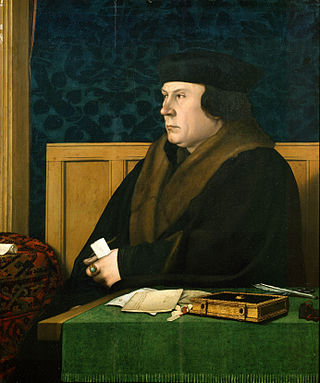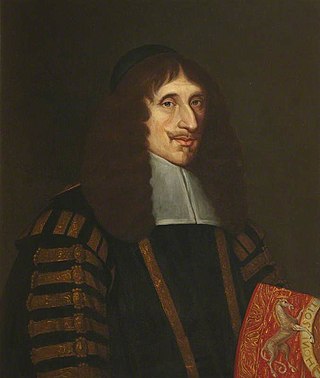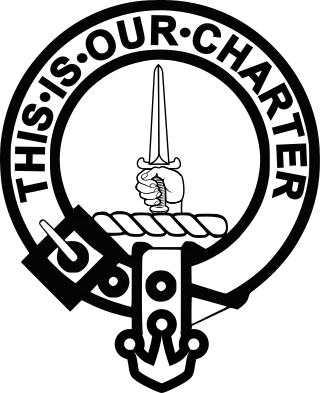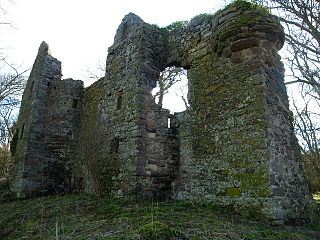Life
He was the elder son of Robert Colville of Ochiltree and Margaret Logan. He was one of the commissioners to parliament on 15 February 1525. He was appointed to the office of comptroller by 1525, when he made an account of household expenses for James V of Scotland. [2]
In 1529 he exchanged the lands of Ochiltree with James Hamilton of Finnart for the lands of Easter Wemyss and Lochorshyre in Fifeshire. The same year he was appointed a director of the chancery. He was one of the commissioners to parliament on 24 April and 13 May 1531, 15 December 1535, and 29 April 1536. He was nominated a lord of the articles on 13 May 1532 and 7 June 1535, and at the latter date was chosen a commissioner for the taxation of £6,000 voted by the three estates to James V of Scotland on his approaching marriage. [3]
On the institution of the College of Justice in 1532, Colville was appointed one of the judges on the temporal side of the bench, and was knighted. He was one of the commissioners at the truce of Newcastle on 8 October 1533, and was sent again into England to treat for peace in the following year. [3]
For siding with the Douglases he was in 1538 deprived of the office of comptroller. In November, the English border official Thomas Wharton heard that the secretary Adam Otterburn of Auldhame was imprisoned at Dumbarton Castle for speaking with the banished Douglas family and James Colville was in prison for "his accomptes". [4] David Wood of Craig was made comptroller in his place.
On 30 May 1539 a summons of treason was executed against him for affording them countenance and assistance. He appeared to answer to the charge before the parliament on 18 July 1539, when the only charge persisted in against him was that while comptroller he, on 14 July 1528, had made a pretended assignation for the benefit of Archibald Douglas of Kilspindy, when he knew that a summons of treason against him had been at that time executed. For this he was ordered on 21 August to enter himself in ward in Blackness Castle. He disobeyed this order, and, back in England, associated with Archibald Douglas, 6th Earl of Angus, and his brother in treason attempts against the Scottish king. [3]
Colville died in 1540. On 10 January 1541, a summons was executed against his widow and children, on account of his having incurred the crime of lèse-majesté . His estate was annexed to the crown, but was then bestowed on Norman Leslie of Rothes. The forfeiture was rescinded in parliament on 12 December 1543, under the direction of Cardinal Beaton. [3]

Thomas Cromwell, briefly Earl of Essex, was an English lawyer and statesman who served as chief minister to King Henry VIII from 1534 to 1540, when he was beheaded on orders of the king, who later blamed false charges for the execution.

John Campbell, 1st Earl of Loudoun was a Scottish politician and Covenanter.

William Paulet, 1st Marquess of Winchester, styled Lord St John between 1539 and 1550 and Earl of Wiltshire between 1550 and 1551, was an English Lord High Treasurer, Lord Keeper of the Great Seal, and statesman.

James Hamilton, 1st Duke of Châtellerault, 2nd Earl of Arran, was a Scottish nobleman and head of the House of Hamilton. A great-grandson of King James II of Scotland, he was heir presumptive to the Scottish throne. Arran was Regent of Scotland during the minority of Mary, Queen of Scots from 1543 to 1554, when he lost the regency to Mary of Guise. At first pro-English and Protestant, he converted to Catholicism in 1543 and supported a pro-French policy. He reluctantly agreed to Mary's marriage to Francis, eldest son of King Henry II of France, and was rewarded by Henry by being made Duke of Châtellerault in 1549. During the Scottish Reformation, Châtellerault joined the Protestant Lords of the Congregation to oppose the regency of Mary of Guise, and lost his French dukedom as a result.

Sir James Hamilton of Finnart was a Scottish nobleman and architect, the illegitimate son of James Hamilton, 1st Earl of Arran, and Marion Boyd of Bonshaw. Although legitimated in 1512 while still a minor, he continued to be known as the "Bastard of Arran". As a key member of the Hamilton family, and second cousin of James V, King of Scotland, he became a prominent member of Scottish society.

Sir John Gage KG was an English courtier during the Tudor period. He held a number of offices, including Chancellor of the Duchy of Lancaster (1542–1547), Comptroller of the Household (1540–1547), Constable of the Tower (1540–1556) and Lord Chamberlain (1553–1556).

Clan Charteris is a Scottish clan of the Scottish Lowlands.

Clan Colville is a Lowland Scottish clan.
David Wemyss, 4th Earl of Wemyss was a Scottish peer and Member of Parliament who served as Lord High Admiral of Scotland from 1706 to 1714.
Events from the 1530s in England.
Archibald Douglas, Earl of Angus, 1st Earl of Ormond (1609–1655) was the eldest son of William Douglas, 1st Marquis of Douglas, from whom he obtained the courtesy title of Earl of Angus. Douglas was a member of privy council of Scotland, 1636; vacillated in his opinions on the new service-book, originally (1636) approving its use. Appointed extra ordinary lord of session in 1631. He signed the covenant, was unwilling to take up arms in its defence, but was a commissioner for the covenanters in England in 1643. In 1646 made colonel of Régiment de Douglas in France when his brother Lord James Douglas, was killed in action. Member of committee of estates in 1650. Created Earl of Ormond in 1651; fined £1,000 by Cromwell's Act of Grace, 1654.
Norman Leslie, was a 16th-century Scottish nobleman. The leader of the party which assassinated Cardinal Beaton, he was forced to flee Scotland, serving the monarchs of England and France. He died serving the latter in 1554.

Sir Adam Otterburn of Auldhame and Redhall was a Scottish lawyer and diplomat. He was king's advocate to James V of Scotland and secretary to Mary of Guise and Regent Arran.
James Kirkcaldy of Grange, a Fife laird and treasurer of Scotland.
Andrew Stewart, 2nd Lord Avondale or Andrew Stuart, 1st Lord Ochiltree, was a Scottish peer.
Sir James Foulis, was a Scottish judge and Senator of the College of Justice.

Ochiltree Castle was a castle built on a promontory by the Lugar Water, East Ayrshire, Scotland across from Auchinleck Castle. Built by the de Colville family in the 12th century, it was destroyed in 1449, by Sir William Douglas.

The Cunninghams of Drumquhassle were a family of the landed gentry in Scotland from the early 16th century to the mid-17th. They are linked to the Cunninghams of Kilmaurs in Ayrshire, being descended through junior lines via the Cunninghams of Polmaise. At their greatest extent, their lands included Mugdock-Mitchell and the house at Killermont, covering the part of parishes of Strathblane and New Kilpatrick. John Cunningham, the third laird held several positions of responsibility within the Scottish court, including Master of the Royal Household for James VI and a Collector General of tax during the regency of the Earl of Lennox, but his involvement in the power struggles between the Scottish nobility and the court of Elizabeth I of England also led to his demise and he was executed for treason in 1585. Over the next century, the family lost its land and power – in the mid-17th century, the Cunninghams sold their country house in Drumquhassle in rural Stirlingshire and it passed to the Govane family.
The Comptroller of Scotland was a post in the pre-Union government of Scotland.
![]() This article incorporates text from a publication now in the public domain : Stephen, Leslie, ed. (1887). "Colville, James". Dictionary of National Biography . Vol. 11. London: Smith, Elder & Co.
This article incorporates text from a publication now in the public domain : Stephen, Leslie, ed. (1887). "Colville, James". Dictionary of National Biography . Vol. 11. London: Smith, Elder & Co.









